Reference: Interim Storage Facility Information Center (The Soil Separation Facility in Okuma Construction Section No.1)
Hello, everyone. My name is Daichi, an expert providing the information on the radiation issues in an easy-to-understand manner.
So far regarding the decontamination activities, objectives, procedures and treatment of soil and waste arising from the decontamination activities have been covered.
This article and a couple of following articles, the Interim Storage Facility will be covered, which temporarily stores soil and waste arising from the decontamination activities in Fukushima Prefecture.
Regarding the Interim Storage Facility, this article covers the following questions:
– What is the Interim Storage Facility used for?
– Where is the Interim Storage Facility?
– What kind of facilities are there in the Interim Storage Facility?
Table of contents of this article
- (First let’s learn its overview) What is the Interim Storage Facility? (No. 1)
- What is the Interim Storage Facility is used for?
- Where is the Interim Storage Facility?
- Final disposal of stored soil and waste
- What kind of facilities are there in the Interim Storage Facility?
- Storage Site
- Soil Separation Facility
- Soil Storage Facility
- Temporary Incineration Facility and Temporary Ash Treatment Facility
- Waste Storage Facility
- Other facilities
- Summary
I have been involved with the radiation-relevant issues, like the policy on the decontamination activities and the management of the Interim Storage Facility, after the accident of the Fukushima Daiichi Nuclear Power Plant in 2011.
I received a doctorate in the field of radiation, while working in Fukushima.
(First let’s learn its overview) What is the Interim Storage Facility? (No. 1)
In this article, first the overview of the Interim Storage Facility will be covered, and in the following articles, individual facility, as well as issues to be addressed in the future will be in detail elaborated.
What is the Interim Storage Facility is used for?

We need to know well, what the Interim Storage Facility is used for?
As briefly covered in this article, key points regarding the soil and waste treated in this facility are as follows:
- Soil and waste generated only in Fukushima Prefecture are temporarily stored (those generated in other prefectures are not stored).
- Soil and waste arising from decontamination activities are temporarily stored (radioactivity of removed soil and waste doesn’t matter).
- Specified waste with radioactivity of more than 100,000Bq/kg is temporarily stored (for more information of the Specified Waste, please refer to this article.)
Please keep the above-mentioned 3 key points in your mind, because not all kinds of soil and waste are stored in the Interim Storage Facility.
Where is the Interim Storage Facility?
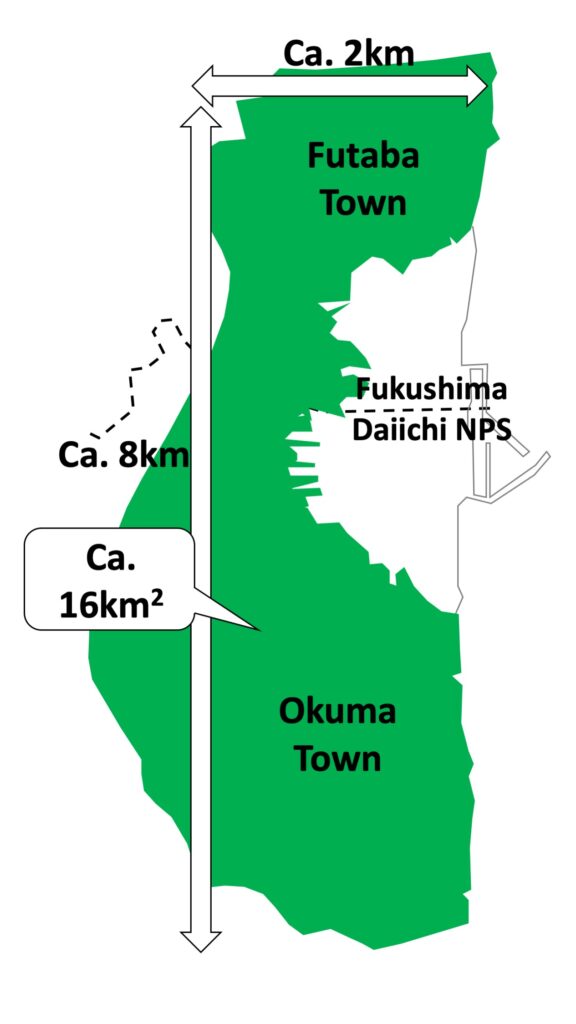
So, where is the Interim Storage Facility located?
Maybe many of you might know that it is in Fukushima.
Yes, it’s correct, and it straddles both Okuma Town and Futaba Town, and surrounds the Fukushima Daiichi NPS.
Its size is around 16km2, and on average it has 2km length between east and west, and 8km length between north and south.
It almost corresponds to the size of Shibuya City (15.1km2) and Nakano City (15.6km2) in Tokyo.
Please bear in your mind, that the Interim Storage Facility almost has a size of a kind of one town.
Final disposal of stored soil and waste

Another key point to be kept in your mind, is that the Interim Storage Facility is, as aforementioned, the facility to temporarily store the soil and waste arising in Fukushima Prefecture, but the soil and waste are supposed to be transported again outside the Fukushima Prefecture for its final disposal.
And this final disposal project is supposed to be completed within 30 years after the start of interim storage in the Interim Storage Facility, that is, by March 2045, and this is stipulated in the JESCO (Japan Environmental Storage and Safety Corporation) Law as follows:
(Responsibility of the national government)
Article 3. The national government takes all possible measures to ensure the reliable and proper implementation of the interim storage and treatment of polychlorinated biphenyl waste.
2. As the measures set forth in the preceding paragraph, the national government develops the facilities necessary for the interim storage, ensures their safety, and takes necessary measures to obtain the understanding and cooperation of residents and other stakeholders in the areas surrounding the facilities. In addition, within 30 years after the start of the interim storage, necessary measures shall be taken to complete the final disposal outside Fukushima Prefecture (provisional translation by myself).
(Reference) the JESCO (Japan Environmental Storage and Safety Corporation) Law (in Japanese)
The amount of soil and waste arising from decontamination activities is estimated as around 14 million m3, excluding the Difficult-to-Return Zones.
It is difficult to find the place which can accommodate all the treated soil, therefore, the nation government is currently promoting recycling policy of the removed soil to reduce its volume to be finally disposed.
The specific measures to promote recycling of the removed soil will be covered in other articles.
What kind of facilities are there in the Interim Storage Facility?
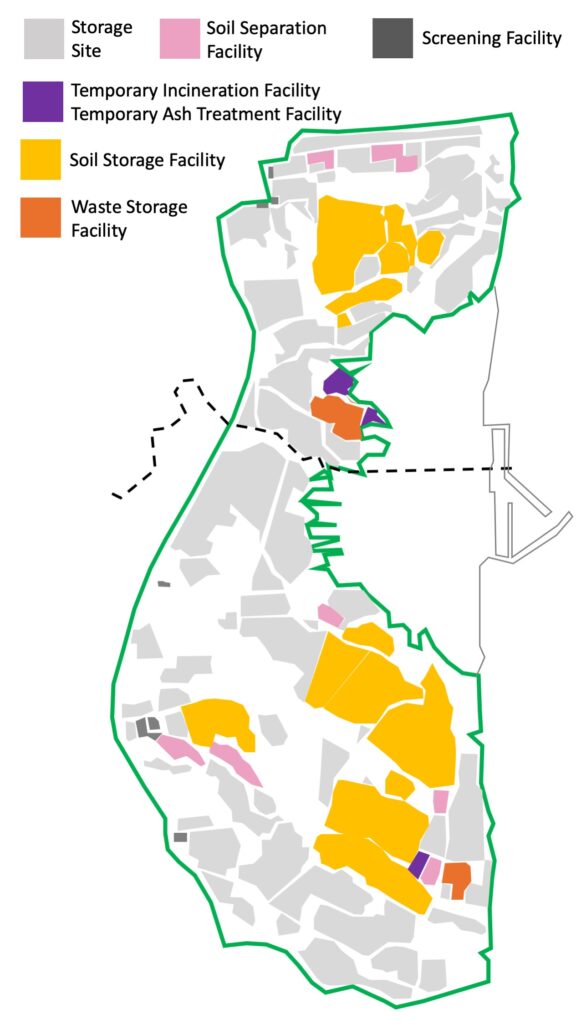
The Interim Storage Facility is not a single small facility, but instead a lot of kinds of facilities are constructed in the wide range of area of the Interim Storage Facility (please refer to the above figure).
Each major facility will be elaborated in the following in sequence.
Storage Site
There are other sites with similar function, but here the Storage Sites are introduced as representative examples.
To make a long story short, the Storage Sites are facilities to temporarily store the removed soil and waste, which are transported from outside the premise of the Interim Storage Facility, before the removed soil and soil are further transported to the facilities for its treatment (e.g. the Soil Separation Facility).
It is surely effective, if trucks transport them directly to the relevant treatment facilities (e.g. the Soil Separation Facility), because procedures (e.g.: unloading, loading, storage) can be omitted, but sometimes they are needed to be temporarily stored in the Storage Sites, taking account of the capacity of the treatment facilities.
What are stored in the Storage Sites are, for examples, residue of container bags, waste generated through dismantling of residences and other kinds of buildings.
Its structure is almost same with that of the temporary storage sites, as covered in this article, but it is slightly different, depending on kinds of stored waste.
Soil Separation Facility
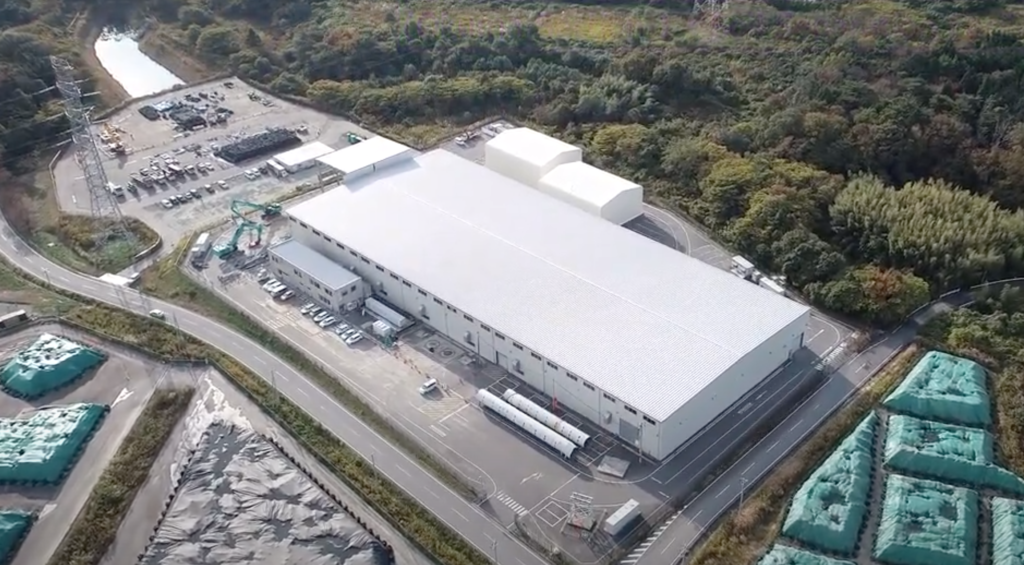
As its name represents, the Soil Separation Facility is the facility, in which removed soil is separated with sieving machines, as a pretreatment procedure before the treat soil is transported into the Soil Storage Facility.
Details are covered in this article, but in this facility the removed soil is sieved twice to remove big stones and organic matters, including leaves and branches.
And finally only soil whose diameter is less than 2cm is supposed to be transported and stored in the Soil Storage Facility.
Soil Storage Facility
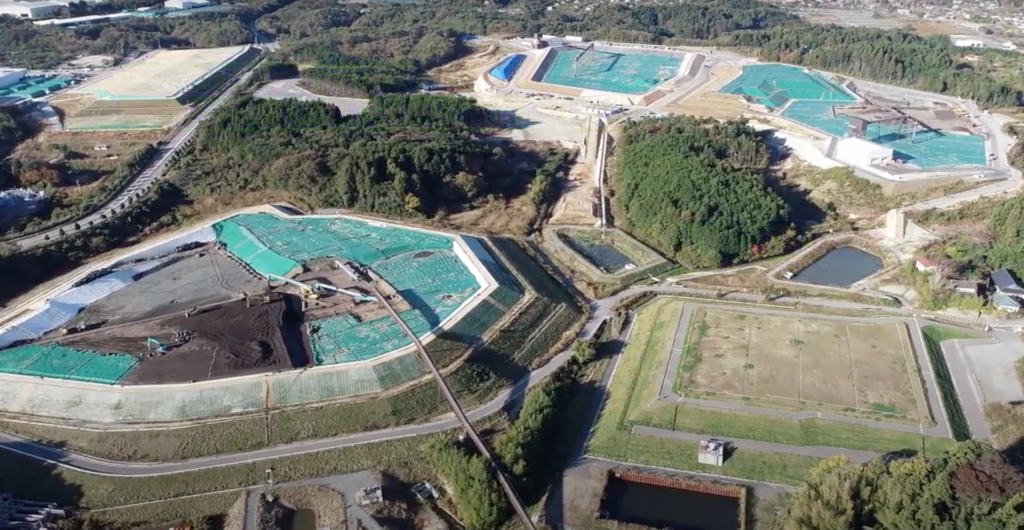
The Soil Storage Facility is also elaborated in this article, but this is the facility to temporarily store the soil treated in the above-mentioned Soil Separation Facility.
Its height will be 15m at the highest, and its volume will be more than 3 million m3 at maximum, depending on the land shape.
The period of time for storage is not specifically determined, but as above mentioned, all of the soil is supposed to be finally disposed of outside Fukushima Prefecture by March 2045, so it needs to be stored stably and safely, until it is transported again out of the site in the future.
Temporary Incineration Facility and Temporary Ash Treatment Facility
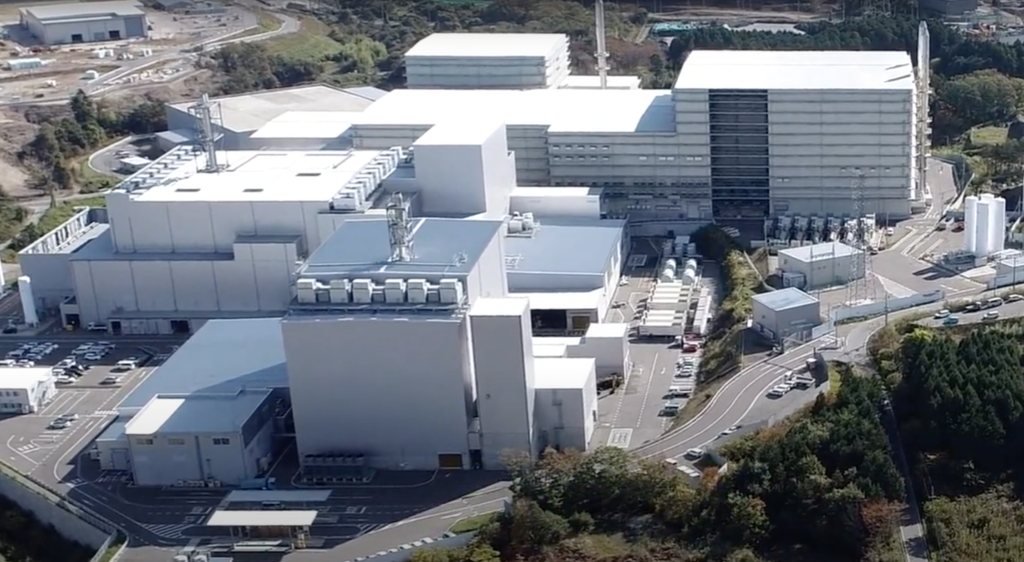
The Temporary Incineration Facilities are constructed outside the Interim Storage Facility, but also inside the premise of the Interim Storage Facility, 3 facilities are constructed with different kinds of furnaces.
Here the burnable including grass, leaves and branches, as well as residues of container bags, are incinerated for their volume reduction.
Ash (bottom ash and fly ash) generate in the Temporary Incineration Facility, followed by transportation to the Temporary Ash Treatment Facility.
In addition, slags are generated from the part of the Temporary Incineration Facilities, but they are temporarily stored till their recycling in the future.
In the Temporary Ash Treatment Facility, ash is melted under the high-temperature environment, and slags are generated by rapidly cooling the melted ash.
The slags are stored together with slags generated in the Temporary Incineration Facilities.
And metals are collected during the ash treatment procedures, and they are temporarily stored till their recycling in the future.
Fly ash is generated also in the Temporary Ash Treatment Facility and it is going to be stored for a long time in the Waste Storage Facility, till its further treatment procedures.
Waste Storage Facility
As aforementioned, in the Waste Storage Facility, fly ash generated in the Temporary Ash Treatment Facility is stored.
This fly ash is generated through further volume reduction of ash, which is generated in the Temporary Incineration Facility through volume reduction of organic matter like leaves and branches.
Therefore, it is difficult for the volume of the fly ash to be further reduced, and even if the volume of the fly ash can be reduced, it would not be so energy-efficient.
During this procedure, radioactive cesium, one of the major radionuclides which are still remaining in the environment, will be accumulated into the fly ash, and proportion of radioactive cesium, which remains in slags and metals, will be very low.
As a result of this, concentration of radioactivity in the slags and metals will be reduced to the low level, which make it possible for them to be recycled, but instead the radioactivity concentration in the fly ash will become much higher.
Details are covered in this article.
Other facilities
The above-mentioned facilities are major facilities to treat soil and waste brought to the Interim Storage Facility, and the treatment procedures in each facility are elaborated in this article and this article.
In addition, there are the Screening Facility, the Technology Demonstration Facility, the Information Center and other relevant facilities, in and near the Interim Storage Facility, but they are also covered in this article.
Summary
This article covers the overview of the Interim Storage Facility, especially focusing on its size, intended soil and waste to be stored, deadline for its storage, major facilities in the premise.
By the way, above-mentioned contents are summarized in the following videos.
It would be appreciated to visit them at your convenience.
– Japanese version
– English version
You can read the same article in Japanese here.
Thank you very much for reading this article.
See you next time!
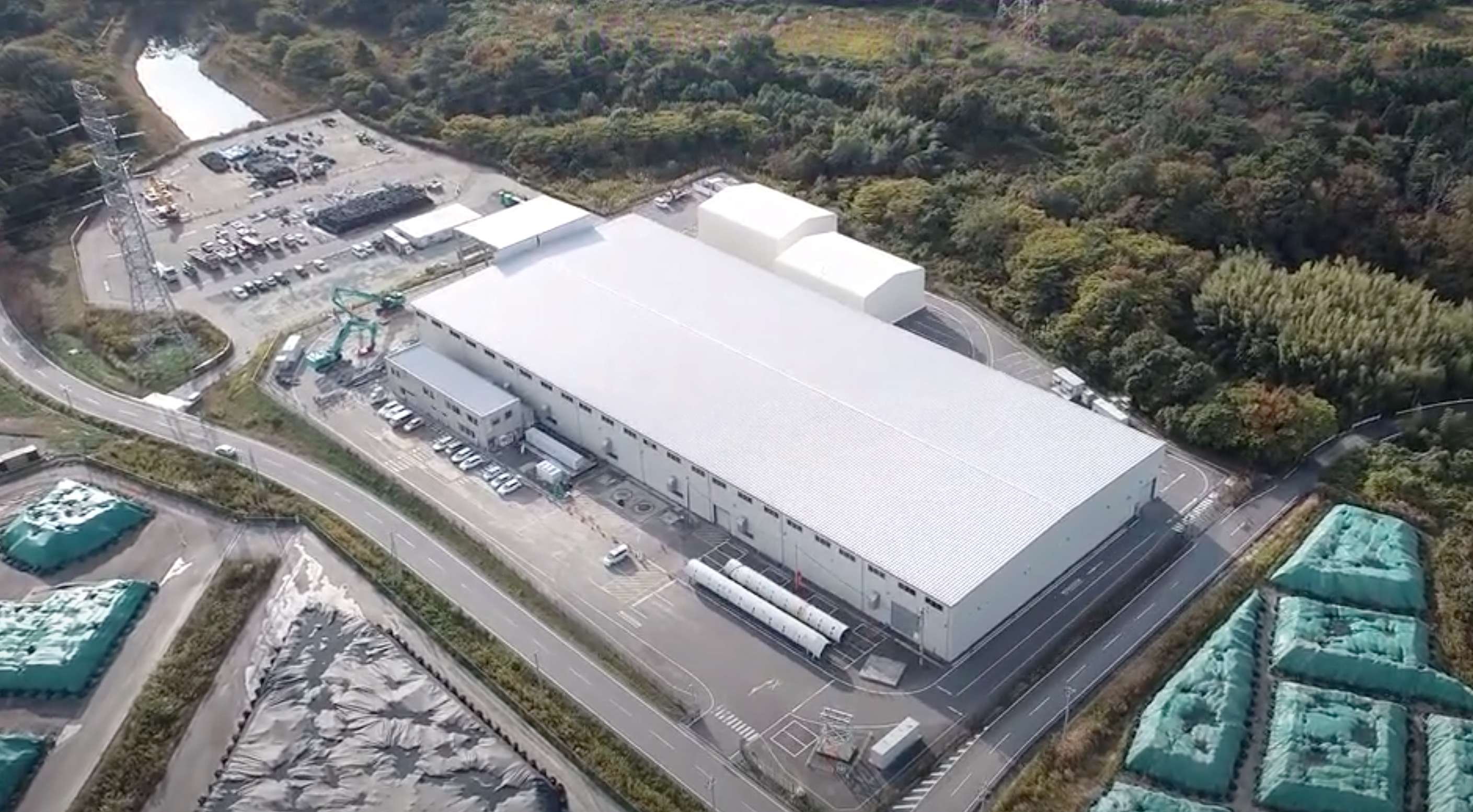


コメント